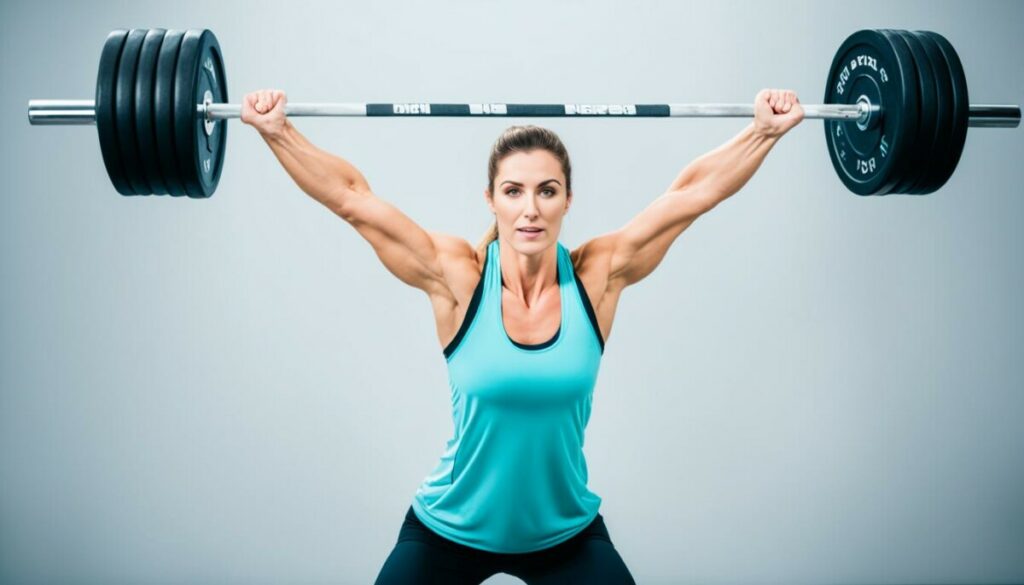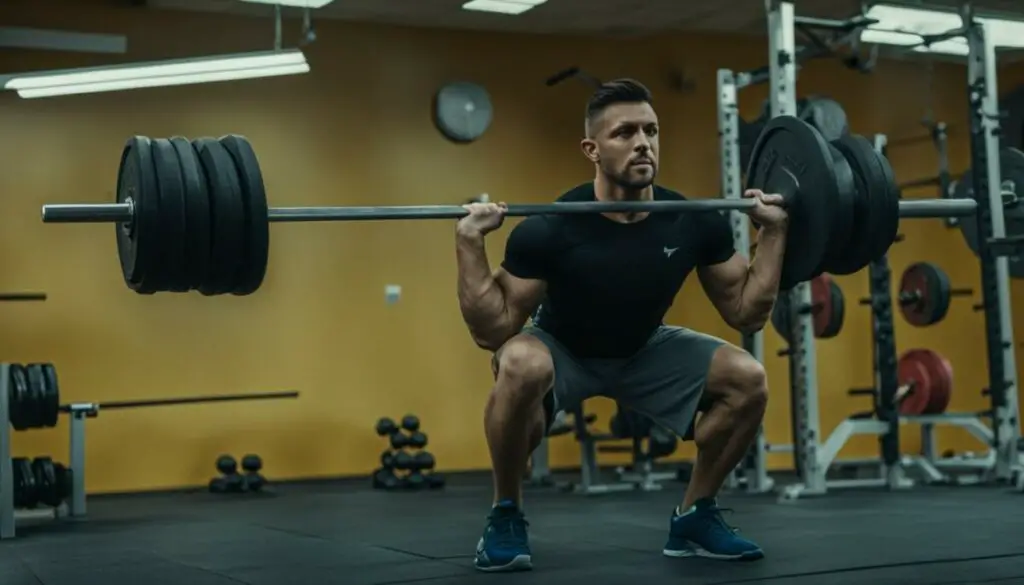Last Updated on 3 months by Francis
The overhand barbell row is a popular back exercise in strength training and weightlifting. It targets the muscles in your back, making it an effective upper body workout for building strength and muscle mass. Whether you’re a bodybuilder, athlete, or fitness enthusiast, mastering the proper technique for the overhand barbell row is essential for maximizing your gains.
In this article, we will guide you through the step-by-step process of performing the overhand barbell row correctly, ensuring you get the most out of this powerful exercise. From the benefits of the barbell row to the proper form and technique, we have you covered.
Contents
Key Takeaways:
- The overhand barbell row is a back exercise that targets multiple muscles in the upper body.
- Proper form and technique are crucial for maximizing the benefits and preventing injuries.
- Engaging the target muscles, maintaining control, and avoiding a rocking motion are key principles to follow.
- Choosing an appropriate weight and load is important to ensure proper execution and reduce the risk of lower back injury.
- Regularly incorporating back-strengthening exercises like the barbell row can help improve posture, reduce back pain, and prevent future back problems.
Barbell Row Benefits

The barbell row is a versatile exercise that offers numerous benefits for the back and other muscle groups. By incorporating this compound movement into your workout routine, you can target various muscles, improve your posture, and increase your overall strength.
Targeted Muscles
The barbell row primarily focuses on the muscles in your back, including the lats, rhomboids, traps, and rear delts. These muscles play a crucial role in maintaining a strong and stable upper body.
Additionally, the barbell row engages the rotator cuffs and other shoulder stabilizer muscles, which help protect your shoulder joints from injuries during various activities. By strengthening these muscles, you can enhance your shoulder stability and prevent common shoulder problems.
The rowing motion of the barbell row also activates the glutes and core muscles, leading to improved stability and balance. This exercise can help you develop a stronger and more functional core, crucial for maintaining proper posture and protecting your spine during everyday activities.
Moreover, the underhand grip variation of the barbell row targets the biceps, brachialis, and forearms, providing an additional benefit for upper body muscle development and overall arm strength.
Posture Improvement
Poor posture is a common issue caused by sedentary lifestyles and muscle imbalances. The barbell row is an effective exercise for improving posture by strengthening the muscles that support an upright position.
Through the barbell row, you can develop stronger back muscles, including the lats, rhomboids, and traps, which are responsible for pulling your shoulders back and keeping your spine in proper alignment. By incorporating this exercise into your routine, you can correct muscle imbalances, reduce rounded shoulders, and ultimately achieve better posture.
Muscle Development and Strength
The barbell row is a compound exercise that involves multiple muscle groups, making it an efficient way to build overall upper body strength. By continually challenging these muscles with progressive overload, you can promote muscle growth and development over time.
Additionally, the barbell row helps to improve your pulling strength, which translates to better performance in various activities such as lifting heavy objects or participating in sports that involve rowing or pulling movements.
Overall Benefits Summary
In summary, the barbell row offers a range of benefits, including:
- Targeting back muscles such as the lats, rhomboids, traps, and rear delts
- Engaging rotator cuffs and shoulder stabilizers for improved shoulder health
- Activating glutes and core muscles for enhanced stability and balance
- Building upper body strength and muscle development
- Improving posture by correcting muscle imbalances
Through consistent practice and proper form, the barbell row can be a valuable addition to your workout routine, helping you achieve your fitness goals and maintain a strong and healthy body.
How to Do the Barbell Row

Mastering the barbell row technique is essential for a successful upper body workout. Proper form and execution can maximize the benefits of this exercise while minimizing the risk of injury. Follow these step-by-step instructions to perform the barbell row with precision and efficiency.
- Load the barbell: Start by adding weights to the barbell and securing them in place. Ensure the weight is appropriate for your fitness level and goals.
- Stance and grip: Stand with your feet hip-width apart, maintaining a solid base. Take an underhand grip on the barbell, with your hands shoulder-width apart.
- Neutral head position: Keep your head in a neutral position, looking down towards the floor. Avoid tilting your head up or hyperextending your neck.
- Engage glutes and core: Squeeze your glutes and engage your core muscles to create tension in your lower body. This stability will help you maintain proper form throughout the movement.
- Raise your torso: Raise your torso slightly, ensuring your back is flat and in line with your hips. Avoid rounding or arching your back as you prepare to initiate the rowing motion.
- Elbow and shoulder movement: Using a smooth and controlled motion, pull the barbell towards your ribcage, aiming to break it against your chest. Focus on engaging your back muscles and pulling with your elbows, rather than relying solely on your biceps.
- Maintain bar control: Throughout the movement, maintain control of the barbell. Avoid jerking or swinging the weight, as this can compromise your form and increase the risk of injury.
- Lower the weight: With the same control and precision, lower the barbell back down to the starting position, extending your arms fully. Feel the stretch in your back muscles as you release the tension.
Remember to perform the barbell row with proper form and range of motion for optimal results. Incorporating the underhand grip, maintaining a neutral head position, engaging your glutes and core, and focusing on elbow and shoulder movement are key elements of the exercise. By mastering these techniques and controlling the barbell throughout the movement, you’ll effectively target your back muscles while minimizing the risk of injury.
Reverse That Grip

When it comes to performing the barbell row, the grip you choose can have a significant impact on your biceps activation and shoulder health. While both the overhand and underhand grips can be used, starting with the underhand grip is highly recommended, especially for beginners.
By using the underhand grip, you engage the biceps to a greater extent, effectively targeting and activating these muscles during the rowing motion. This not only helps in developing stronger and more defined biceps but also adds an additional challenge to the exercise.
Another advantage of the underhand grip is its positive impact on shoulder health. It prevents internal rotation of the shoulder joint, reducing the risk of injuries and promoting better shoulder stability. This is particularly crucial for individuals with pre-existing shoulder issues or those looking to prevent shoulder problems in the long run.
While the overhand grip can also be incorporated into your barbell row routine as you progress, starting with the underhand grip allows you to gradually build strength, stability, and technique.
To summarize, the underhand grip on the barbell row not only activates the biceps to a greater extent but also helps maintain good shoulder health by preventing internal rotation. It is an ideal choice, especially for beginners, to maximize the benefits of the exercise.
| Overhand Grip | Underhand Grip | |
|---|---|---|
| Biceps Activation | Less activation | More activation |
| Shoulder Health | No significant benefit | Prevents internal rotation, promotes stability |
| Suitable for Beginners | Yes | Highly recommended |
| Progression | Can be incorporated over time | Starting point, gradual strengthening |
As shown in the table above, the underhand grip outperforms the overhand grip in terms of biceps activation and shoulder health. Starting with the underhand grip sets a solid foundation for your barbell row journey.
No Rocking

One common mistake during the barbell row is using a rocking motion, where the torso and waist move excessively. This takes emphasis off the target muscles (lats and rhomboids) and increases the risk of lower back strain. It is important to keep the torso quiet and focus on proper form to effectively work the back muscles.
Proper Form for Targeting Lats and Rhomboids
To target the lats and rhomboids effectively during the barbell row, it is crucial to maintain proper form. This involves keeping the torso steady and avoiding any excessive rocking motion. By focusing on a controlled movement and engaging the correct muscles, you can maximize the benefits of this exercise.
Remember, the key to a successful barbell row is to isolate and work the target muscles (lats and rhomboids) while avoiding strain on the lower back. Keep your focus on maintaining proper form and executing the exercise with precision.
Tips for Avoiding Lower Back Strain
To minimize the risk of lower back strain during the barbell row, follow these tips:
- Maintain a neutral spine alignment throughout the exercise.
- Engage your core muscles to stabilize your body.
- Control the movement and avoid using momentum or excessive force.
- Gradually increase the weight as your strength and technique improve.
Benefits of Targeting Lats and Rhomboids
Targeting the lats and rhomboids is essential for building a strong and well-rounded back. These muscles play a crucial role in stabilizing the shoulder blades, improving posture, and supporting various upper body movements. By incorporating exercises that specifically target the lats and rhomboids, such as the barbell row, you can enhance your overall strength and physique.
| Benefits of Targeting Lats and Rhomboids |
|---|
| Improved posture |
| Enhanced upper body strength |
| Stabilization of the shoulder blades |
| Reduced risk of shoulder injuries |
Keep Pulling

During the barbell row, it is important to keep pulling upwards and focus on maintaining tension throughout the movement. By doing so, you can maximize the benefits of this exercise. Maintaining tension helps to activate the targeted muscles and promote muscle growth.
Avoid the tendency to buck your chest towards the bar at the end of each row rep. Instead, aim to bring the bar to your chest and keep your torso as quiet as possible. This ensures a full range of motion and a quiet, smooth motion.
| Tips for Maintaining Tension | Benefits |
|---|---|
| Focus on pulling with your back muscles, rather than relying on momentum or other muscle groups. | Enhances back muscle engagement and promotes muscle development in the upper body. |
| Squeeze your shoulder blades together at the top of each row rep. | Improves posture, strengthens the upper back, and reduces the risk of injuries related to poor posture. |
| Keep your core engaged throughout the entire movement. | Stabilizes your spine and enhances overall strength and control during the exercise. |
Remember to maintain a controlled pace throughout the exercise, focusing on the muscle groups being targeted. By keeping tension, achieving a full range of motion, and performing each rep with a quiet and smooth motion, you can maximize the effectiveness of the barbell row and optimize your strength training routine.
Careful With Weight and Load
When performing the barbell row, it can be tempting to load up the barbell with heavy weights to challenge yourself. However, it is crucial to exercise caution and prioritize proper technique to avoid lower back injuries. Using excessive weight can lead to compromised form and put excessive strain on your lower back.
To ensure a safe and effective workout, it is recommended to choose a weight that allows you to maintain proper form throughout the exercise. This includes keeping your back straight, shoulders squared, and engaging your core muscles. Select a weight that allows you to complete 8 to 10 repetitions without sacrificing form.
The focus should be on quality over quantity. By using weights that are appropriate for your strength and skill level, you can better target the muscles in your back without putting unnecessary stress on your lower back. Remember, it’s better to start with lighter weights and gradually increase the load as you gain strength and confidence.
Proper weight selection and technique not only help you avoid lower back injuries but also maximize the benefits of the barbell row exercise. So take your time, listen to your body, and prioritize safety while challenging your muscles.
Importance of Back Strengthening Exercises

The back muscles are often neglected and underused, which can lead to posture problems and discomfort. Improving the strength of these muscles is vital for maintaining a healthy and pain-free back.
One common issue arising from neglected back muscles is poor posture. Weak back muscles contribute to the slouching and hunching that many people experience, which can lead to long-term posture problems. By incorporating back strengthening exercises into a regular fitness routine, it is possible to reverse these effects and improve overall posture.
Another significant benefit of back strengthening exercises is the reduction of back pain. Strong back muscles provide support for the spine and contribute to its stability. When these muscles are weak, the spine is more susceptible to misalignment and injury, resulting in chronic back pain. By engaging in regular strength training exercises that target the back muscles, such as the barbell row, individuals can reduce back pain and promote a healthier back.
Strength training exercises, like the barbell row, not only target the neglected back muscles but also engage surrounding muscle groups. This comprehensive approach to strength training helps to improve overall strength and stability in the entire back and core area. By developing stronger back muscles, individuals can reduce the risk of future back problems and maintain a healthier back for years to come.
| Benefits of Back Strengthening Exercises | SEO Keywords |
|---|---|
| Improves posture | posture problems |
| Reduces back pain | back pain, reducing back pain |
| Prevents future back problems | preventing back problems |
| Strengthens neglected back muscles | neglected back muscles, strength training |
Regular strength training exercises, like the barbell row, are essential for maintaining a healthy back, improving posture, reducing back pain, and preventing future back problems. By incorporating these exercises into your fitness routine, you can strengthen neglected back muscles and promote optimal back health.
Benefits of the Barbell Bent Row
The barbell bent row is an effective back resistance exercise that primarily targets the latissimus dorsi, the large muscles in the middle of the back. However, it also engages other important muscles such as the trapezius, rhomboids, and rotator cuff muscles. By incorporating the barbell bent row into your workout routine, you can experience a wide range of benefits that contribute to overall muscle development, improved posture, and reduced risk of muscle imbalances and injuries.
One of the key benefits of the barbell bent row is its ability to strengthen the latissimus dorsi, commonly known as the lats. These muscles play a significant role in pulling movements and are responsible for many upper body actions, such as pulling yourself up on a chin-up bar or rowing a boat. By targeting and strengthening the lats, you can enhance your ability to perform these activities with greater ease and efficiency.
In addition to the latissimus dorsi, the barbell bent row engages other muscles in the upper back, including the trapezius, which runs along the spine and helps to stabilize the shoulder blades, and the rhomboids, which help retract the scapulae. The rowing motion of this exercise also activates the rotator cuff muscles, which are essential for shoulder stability and injury prevention.
By strengthening these upper body muscles, the barbell bent row can lead to improved posture. Many individuals experience muscle imbalances due to a sedentary lifestyle or exercises that predominantly target the anterior muscles, such as push-ups or bench presses. These imbalances can contribute to rounded shoulders and a hunched posture. The barbell bent row helps to counteract these imbalances by strengthening the muscles responsible for pulling the shoulder blades back and down, promoting an upright and aligned posture.
“The barbell bent row is a versatile exercise that targets multiple upper body muscles, helping to improve posture and reduce the risk of muscle imbalances and injuries.”
Another advantage of the barbell bent row is its contribution to balanced muscle development in the upper body. By engaging various muscles in the back and shoulder region, this exercise aids in achieving proportional strength and muscle development. This is particularly important for individuals seeking a balanced physique and overall strength.
It’s worth noting that proper form and technique are crucial to maximize the benefits and avoid injury. Focus on maintaining a flat back, engaging the core for stability, and pulling the barbell towards the lower ribs with controlled and deliberate movements. Starting with lighter weights and gradually increasing the load will allow for proper form and ensure optimal results.
In summary, the barbell bent row offers numerous benefits, including targeted resistance training for the back muscles, improved posture, balanced upper body muscle development, and reduced risk of muscle imbalances and injuries. By incorporating this exercise into your workout routine, you can enhance your overall strength and achieve a more balanced and healthy physique.
Barbell Bent Row Form
To perform the barbell bent row with proper technique, follow these steps:
- Start by positioning yourself with a flat back and a hip hinge stance. This means bending forward at the hips while keeping your back straight.
- Engage your core muscles throughout the exercise to maintain stability and control.
- Squeeze your shoulder blades together to activate the muscles of your upper back.
- Maintain control and focus on pulling the barbell up towards your chest using your elbows. Avoid using excessive momentum or swinging.
- Avoid excessive movement of the spine during the exercise. Keep your back neutral and aligned throughout the movement to prevent strain and injury.
Remember to prioritize proper form and maintain a neutral spine alignment to optimize the effectiveness of the barbell bent row.
| Common Mistakes | Proper Technique |
|---|---|
| Round back and poor posture | Flat back and hip hinge stance |
| Unengaged core | Engage core muscles |
| Shoulders rolled forward | Squeeze shoulder blades together |
| Excessive swinging or momentum | Maintain control and focus on pulling with elbows |
| Spinal strain or injury | Maintain neutral spine alignment |
Barbell Bent Row Tips
To maximize muscle activation during the barbell bent row, focus on two key aspects: elbow movement and shoulder blade squeeze. By closely paying attention to these factors, you can optimize your form and target the specific muscles you want to engage.
Elbow Movement
An essential element of the barbell bent row is the proper movement of your elbows. Instead of using your hands or arms to pull the weight, focus on initiating the movement from your elbows. This helps to ensure that the target muscles in your back are effectively engaged. Keep your elbows close to your body and drive them back as you pull the barbell towards your midsection. This emphasis on elbow movement will help maximize muscle activation and prevent excessive strain on the arms and shoulders.
Shoulder Blade Squeeze
Another crucial aspect of the barbell bent row is maintaining a strong shoulder blade squeeze throughout the exercise. As you row the barbell towards your midsection, consciously squeeze your shoulder blades together at the top of the movement. This activation of the rhomboids and other back muscles increases the workload on those specific muscles, leading to greater muscle development and overall strength. Focus on contracting your back muscles and creating tension in your shoulder blades to ensure maximum activation.
“Elbow movement and shoulder blade squeeze are key factors in optimizing muscle activation during the barbell bent row.”
Grip variations can also play a role in maximizing the effectiveness of the barbell bent row. Experiment with different grip variations, such as an underhand grip, to target the muscles from slightly different angles. This variety can help stimulate muscle growth and prevent plateaus. Additionally, consider incorporating other row variations, such as the Pendlay row or Yates row, into your training routine. These variations challenge the muscles in unique ways, providing additional variety and opportunities for muscle development.
By paying attention to elbow movement, shoulder blade squeeze, grip variations, and row variations, you can enhance the effectiveness of your barbell bent row workouts. Remember to prioritize proper form and always listen to your body to prevent injury and achieve the best results.
Conclusion
The barbell row and barbell bent row are highly effective exercises for developing back muscles, improving posture, and preventing injuries. By focusing on proper form, engaging the target muscles, and incorporating variations, individuals can maximize the benefits of these exercises. Regular strength training that includes these exercises can lead to impressive muscle gains and overall upper body strength.
Performing the barbell row and barbell bent row with the proper form is essential for effective back exercise. By maintaining a neutral spine alignment, avoiding rocking motions, and keeping tension throughout the movement, individuals can ensure the targeted muscles are engaged and worked effectively.
In addition to muscle development, these exercises contribute to posture improvement, which is crucial for overall well-being. Strengthening the back muscles helps maintain proper spinal alignment and reduces the risk of postural imbalances and associated discomfort.
Moreover, incorporating the barbell row and barbell bent row into a strength training routine can help prevent injuries. Building a strong back and upper body not only enhances overall physical abilities but also provides stability and support for daily activities and sports performance. Remember to start with an appropriate weight, focus on technique, and gradually increase the intensity for optimal results and injury prevention.
FAQ
What muscles does the barbell row target?
The barbell row primarily targets the lats, rhomboids, traps, and rear delts. It also engages the rotator cuffs, shoulder stabilizers, glutes, and core muscles.
Can the barbell row work the biceps and forearms?
Yes, the underhand grip variation of the barbell row can also target the biceps, brachialis, and forearms.
How do I perform the barbell row with proper form?
Start by loading the barbell with weights and standing with feet hip-width apart. Take an underhand grip on the barbell, keep your head in a neutral position, and squeeze your glutes and core. Use the elbow and shoulder joints to row the barbell up to your ribcage, aiming to break it against your chest. Lower the weight back down under control.
Should I use an overhand grip or an underhand grip for the barbell row?
The underhand grip is recommended, especially for beginners. It allows for more biceps activation and also helps maintain shoulder health by preventing internal rotation. Both grips can be used over time, starting with the underhand grip is beneficial.
What is the common mistake to avoid during the barbell row?
One common mistake is using a rocking motion with excessive torso and waist movement. This takes emphasis off the target muscles and increases the risk of lower back strain. It is important to keep the torso quiet and focus on proper form.
Should I pull the bar towards my chest during the barbell row?
Yes, it is important to keep pulling upwards and aim to bring the bar to your chest. Avoid bucking the chest towards the bar at the end of each row rep. Keeping the torso as quiet as possible helps ensure a full range of motion and a smooth motion.
Can I use heavy weights for the barbell row?
While the barbell row can be performed with heavy weights, it is important to exercise caution and avoid excessive loading. Using too much weight can lead to poor technique and a higher risk of lower back injury. It is recommended to choose a weight that allows for proper form and a rep range of 8 to 10 repetitions.
How can the barbell row benefit my back muscles?
The back muscles are often neglected and underused, which can lead to posture problems and discomfort. Regular strength training exercises, including the barbell row, can help strengthen the back muscles, improve posture, reduce back pain, and prevent future back problems.
What muscles does the barbell bent row target?
The barbell bent row primarily targets the latissimus dorsi but also engages other back and shoulder muscles, such as the trapezius, rhomboids, and rotator cuff muscles.
How do I perform the barbell bent row with proper form?
Start by ensuring a flat back and a hip hinge position. Engage the core muscles and keep the shoulder blades squeezed together. Maintain control throughout the movement, focus on pulling with the elbows, and avoid excessive movement of the spine. Maintain neutral spinal alignment to avoid strain and injury.
How can I maximize muscle activation during the barbell bent row?
To maximize muscle activation, focus on pulling with the elbows and keeping the shoulder blades squeezed together at the top of the movement. Experiment with different grip variations and consider trying other row variations, such as the Pendlay row or Yates row, for variety and targeting specific muscles.
What are the benefits of the barbell row and barbell bent row?
The barbell row and barbell bent row are effective exercises for developing back muscles, improving posture, and preventing injuries. By focusing on proper form, engaging the target muscles, and incorporating variations, individuals can maximize the benefits of these exercises. Regular strength training that includes these exercises can lead to impressive muscle gains and overall upper body strength.




.jpg)




